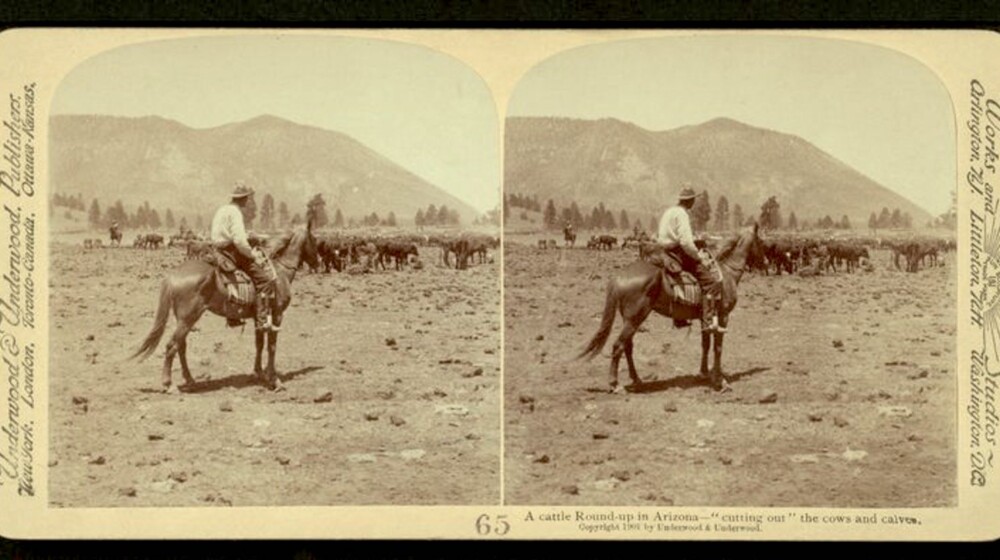C is for Cattle – A History of Ranching in Arizona
For a printable version of this article, please click here.
“The increase of cattell in this yland is marveilous, which from a doozen
of each sort brought thither by the governour, in 25 years he had a hundreth
thousand at the least…” – Richard Hakluyt, about a voyage to the West Indies, 1565
Did you know…
The domestication of animals, between 8000 and 2500 BCE, was a critical achievement in human history. Domesticated animals could be used to help with heavier work, and also provided humans with a reliable food source. Though dogs are the earliest known domesticated animal (15,000 years ago!), cattle were domesticated in the Middle East around 8,000 years ago (bos taurus), and also in India about 2,000 years later (bos incidus). And there is also evidence that cattle could have been domesticated even earlier than that in northern China, over 10,000 years ago.
-
More Info – Branding
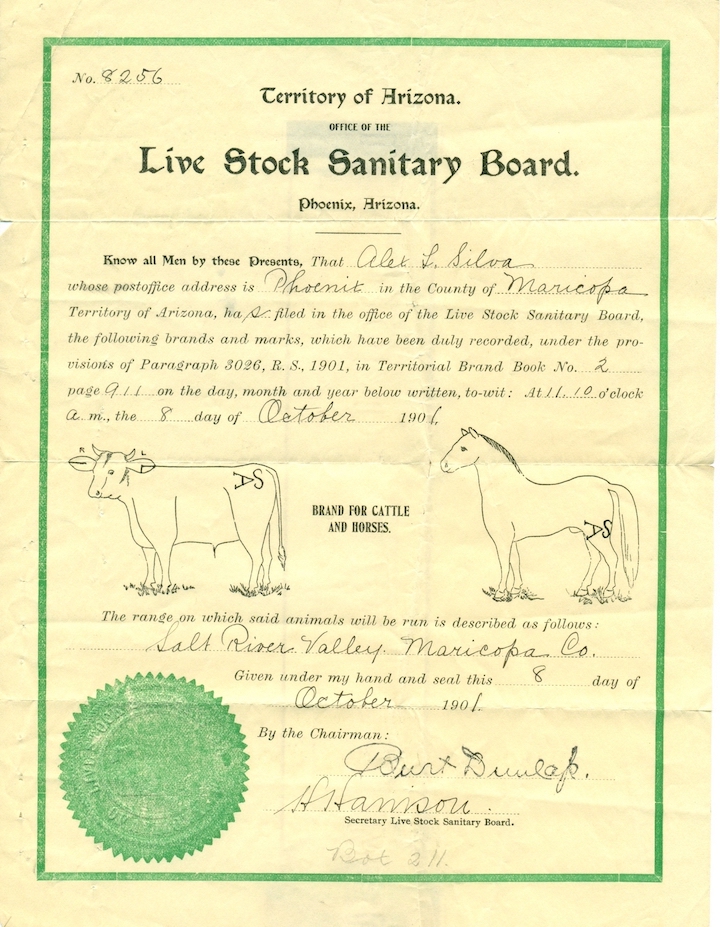 Though it’s more common now to think of brands and branding as connected to the company that sells your favorite kind of coffee or pair of shoes, but branding used to mean permanently marking livestock, particularly cattle. Branding of livestock actually dates back to around 2700 BCE, and was a practice established by the ancient Egyptians in order to permanently mark valuable animals and to deter theft. Spanish conquistador Hernando Cortez is generally thought of as the first person to use a brand on his livestock here in the Americas, in 1541. Connecticut was the first English colony to enact branding laws (February 5, 1644), requiring cattle, sheep, and pigs to be ear-marked or branded, to “prevent disputes and differences that may arise in the owning and claiming of cattle, sheep, and swine that may be lost or stray away.”
Though it’s more common now to think of brands and branding as connected to the company that sells your favorite kind of coffee or pair of shoes, but branding used to mean permanently marking livestock, particularly cattle. Branding of livestock actually dates back to around 2700 BCE, and was a practice established by the ancient Egyptians in order to permanently mark valuable animals and to deter theft. Spanish conquistador Hernando Cortez is generally thought of as the first person to use a brand on his livestock here in the Americas, in 1541. Connecticut was the first English colony to enact branding laws (February 5, 1644), requiring cattle, sheep, and pigs to be ear-marked or branded, to “prevent disputes and differences that may arise in the owning and claiming of cattle, sheep, and swine that may be lost or stray away.”Cattle ranchers in Arizona Territory established the Livestock Sanitary Commission in 1887 to protect the health and wellbeing of farm animals. In 1895, livestock owners were required to register their brand, and the first brand book was published two years later. You can see several years of Arizona Brand Books from the Arizona Memory Project.
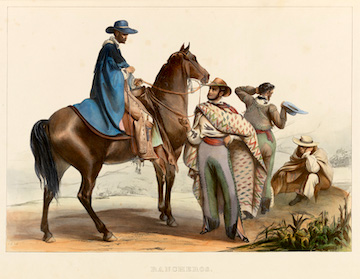
A lithograph of Mexican rancheros, c1834, from the California State Library.
Cattle were introduced to North America through English settlements on the East Coast, French settlements along the St. Lawrence River Valley, and Spanish settlements in present day Florida, Texas, New Mexico, and Arizona. Cattle ranching as we think of it – with open range grazing and cowboys riding horses to herd cattle – was developed in Spain and introduced to the Caribbean Islands as early as 1493, and to Mexico in 1519. When Francisco Vásquez de Coronado lead an expedition north in 1540 through what is now southeastern Arizona to find the mythical Seven Cities of Cibola, he brought livestock, including 150 cattle. In 1598, Juan de Oñate brought 1,299 cattle (including 500 calves and 799 cows, steers, and bulls) along with other livestock with him to settle what is now New Mexico.
Though some of the cattle brought along with those expeditions may have strayed into the desert, cattle ranching itself was firmly established in Arizona by a man named Father Francisco Eusebio Kino. He was a Jesuit priest, originally from Germany, who founded 24 missions in northern Mexico (including what is now southern Arizona) beginning in 1687. Part of his work in both establishing the missions and working with the indigenous population was introducing “secure” (i.e. – European) food sources such as wheat and livestock (cattle, chicken, sheep, etc). By 1819, the number of cattle in the Tucson area reached 5,600 (for reference, the Tucson area’s estimated Spanish and Indigenous population in 1819 was 380 – not quite 15% of the cattle population!), and the Tumacácori Mission 45 miles south of Tucson had 5,500 cattle.
-
More Info – Sheep Ranching in Arizona
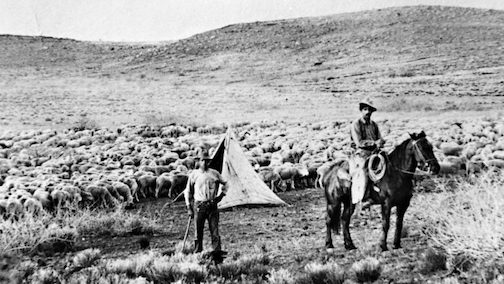
Photo of Michel O’Haco tending his flock north of Phoenix in 1912, courtesy of Kim O’Haco McReynolds, The Tribune.
Sheep were domesticated 10,000 years ago in the Middle East, and have had a significant impact on Arizona. Read more below from the Old Trails Museum, owned and operated by the Winslow Historical Society.
“Sheep ranching has been somewhat overlooked in the telling of Arizona’s history. In the 1500s, Spanish conquistadors began their push northward from Mexico and brought the region’s first sheep as a food source. Father Eusebio Kino introduced sheep into the Pimería Alta in the late 1600s, teaching local Native Americans sheep husbandry to provide a constant supply of wool and meat.
By the 1890s, sheepherding was a major enterprise in Arizona Territory. Many different ethnic groups settled the territory, where American, Mexican, Basque, and Canadian pioneers raised both their families and flocks of sheep. Northern Arizona families such as the Ajas, Candelarias, Jaques, and O’Hacos worked diligently through economic downturns caused by droughts, range wars, government regulations, and a shrinking workforce – sometimes weathering them better than cattle ranchers.
At its height, Arizona’s sheep industry boasted more than 150 sheep owners, and 1.5 million sheep roamed the grasslands. Despite the challenges, several Arizona families and tribal nations still work with sheep, and a few still graze them in the traditional method of moving the animals from the desert ranges to mountain pastures every year with the cyclical rhythm of the land. While it never competed with the five “C’s,” the sheep industry has added a great deal to the economic and ethnic diversity of Arizona.”
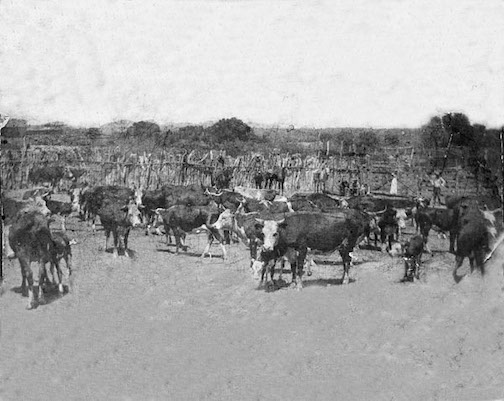 Most of Arizona was ceded to the United States in the Treaty of Guadalupe-Hidalgo after the end of the Mexican-American War in 1848, and the remainder was added in 1853 with the Gadsden Purchase. Formerly Spanish land that became Mexican land with their independence in 1821 now belonged to the United States. With the Homestead Act of 1862, granting 160 acres to anyone who could build a home and work the land, many people came west to start farms and ranches. Americans who came to the Arizona Territory often established ranches at the site of former Spanish or Mexican estates. The Sierra Bonita Ranch, located 27 miles north of Wilcox in eastern Arizona, was founded in 1872 by Colonel Henry Hooker on the site of an abandoned 18th century Spanish estate. Sheriff John Slaughter established his ranch in the San Bernardino Valley (in southeastern Arizona, along the Arizona/Mexico border) in 1884 on the land formerly granted to a veteran of the Mexican War of Independence.
Most of Arizona was ceded to the United States in the Treaty of Guadalupe-Hidalgo after the end of the Mexican-American War in 1848, and the remainder was added in 1853 with the Gadsden Purchase. Formerly Spanish land that became Mexican land with their independence in 1821 now belonged to the United States. With the Homestead Act of 1862, granting 160 acres to anyone who could build a home and work the land, many people came west to start farms and ranches. Americans who came to the Arizona Territory often established ranches at the site of former Spanish or Mexican estates. The Sierra Bonita Ranch, located 27 miles north of Wilcox in eastern Arizona, was founded in 1872 by Colonel Henry Hooker on the site of an abandoned 18th century Spanish estate. Sheriff John Slaughter established his ranch in the San Bernardino Valley (in southeastern Arizona, along the Arizona/Mexico border) in 1884 on the land formerly granted to a veteran of the Mexican War of Independence.
-
More Info – Ranching at the Square
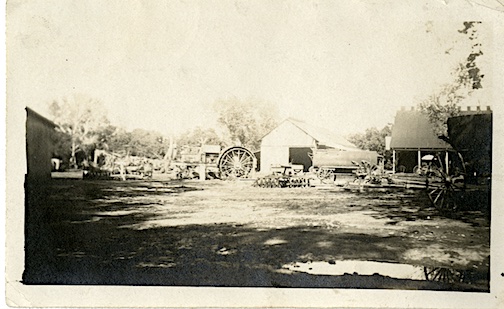
Alejandro and Maria Silva’s Orange Ranch
The buildings at Heritage Square may have always been a part of the town/city of Phoenix, but that doesn’t mean the people who lived there didn’t have ties to ranching, farming, and/or livestock.
-
- The first Heritage Square family to own an automobile were the Higleys, who purchased the home in 1907. This means that everyone prior to that had to rely on walking or horses for transportation. Besides the now restored original carriage house that served the Bouvier-Teeter House, there was a similar building used to stable horses at Rosson House that stood south of the home outside the south-facing door.
- At the first Territorial Exposition/Fair in 1884, Roland Rosson won second premium for his entry of a 1,800 lb. grade cow named Sis, who was noted in the newspaper for being “a fine milker.” As they owned the entirety of Block 14 in those days, they definitely had room for a few livestock, including Sis!
- According to an interview with Jessie Jean (Higley) Lane, her family kept ponies at the Square when their family lived at Rosson House.
- After Prohibition became the law in Arizona in 1915, Billie Gammel lost his livelihood as a saloon owner. In the 1919 Phoenix Directory he and his wife, Frankie, are listed as orange growers, and in the 1923 Phoenix Directory, Frankie is listed as a rancher (Billie is not listed in that Directory).
- Alejandro and Maria Silva owned and operated a very successful farm and ranch in the Alhambra District (Glendale), at what is now 43rd and Bethany Home Road. They raised sheep, cattle, and horses, and diversified their crops by growing citrus trees, sugar cane, California wheat, oats, rye, barley, sweet potatoes, and more. You can learn more about the Silvas by going on a tour of their exhibit at Rosson House, and by exploring our online exhibit about them.
-
By the early 1890s, ranches in the Arizona Territory had a total of 1.5 million cattle and more than a million sheep. Ranches were mostly open range or large, fenced off tracts (barbed wire was invented in 1868 and perfected by Joseph Glidden in 1874), with the cattle grazing on native desert grasses. However, grazing practices that had worked in the Midwest or the East didn’t work as well in the Arizona desert, and poor livestock management lead to overgrazing. This, combined with the worst drought on record in 1892-93 (that is, until 2022!), resulted in up to 75% of Arizona’s range animals (including cattle, sheep, and horses) dying, and many of the remaining were shipped off to market. By June 1893, over 200,000 of Arizona’s cattle had been moved to other states.
“The shipments of starving cattle to California pastures continues…from two to four train loads daily.” Arizona Silver Belt, November 19, 1892
“The cattle loss this winter in Mohave County will be considerable. There has been no rain for the past five months and consequently the grass is very short. Many of the ranges are already overstocked and together with the drought the chances for cattle on these ranges are slim.” Mohave County Miner, December 3, 1892
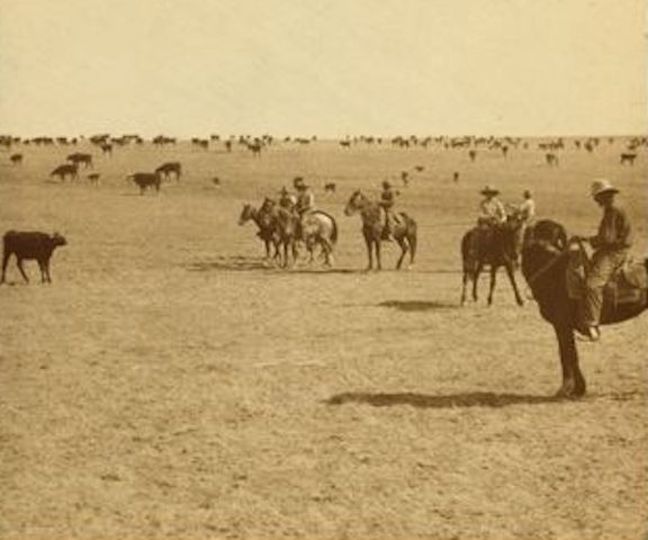
Cowboys on horseback lassoing a yearling (a calf between one or two years old), Sierra Bonita Ranch, Arizona, circa 1890. New York Library Digital Collection.
According to the National Register of Historic Places, at this time “The taxable value of cattle declined almost in half from $12,769,572 in 1893 to $6,591,343 in 1900.” Many people were forced to abandon their farms and ranches. Others, like Alejandro and Maria Silva, joined together with 4,000 other landowners in 1903 to create the Salt River Valley Water Users’ Association, pledging portions of their land to secure a federal loan to build a reliable water storage and delivery system that would save their future crops and livestock from the problems of flooding or drought.
-
More Info – Dude Ranches
Zane Grey. Louis L’Amour. Tom Mix. Gene Autrey. Roy Rogers. Gary Cooper. John Wayne.
With the popularity of cowboys and Westerns in books, on the silver screen, and eventually on TV in the early to mid 20th century, it’s almost inevitable that people would try to recreate and revisit Hollywood’s version of that bygone era themselves. By the 1920s, there were at least 10 “dude ranches” here in Arizona, where guests could relax, get back to nature, enjoy Arizona’s beautiful scenery and temperate winter weather, go on trail rides and hikes, be entertained by rodeo events, eat simple foods, and tell stories by the campfire. Read more about Arizona’s dude ranches from Arizona Highways magazine.
At their height, there were as many as 350 dude or guest ranches in the US, but there was only one of those ranches that welcomed African Americans – the Murray Ranch in Apple Valley, CA. Dude ranches were a popular draw for many Hollywood celebrities, and the Murray Ranch gave stars like Lena Horne, Joe Lewis, and Hattie McDaniel a place to relax and enjoy the ranch lifestyle. The Murrays allowed two movies to be filmed at the ranch in 1939 – The Bronze Buckaroo and Harlem Rides the Range – both starred singing cowboy Herb Jeffries. They also opened the ranch as an alternative to the USO during World War II when it was restricted to whites-only, and let African American and Latinx kids from the area swim in their pool when they were barred from swimming at the pool in town. Read more about the Murrays and their ranch from The Sun newspaper, and check out the spread featuring the ranch in the November 15, 1937 issue of Life Magazine:

The stereoscope card at the top of the page is from the New York Public Library Digital Collection.
Learn about the effect of European foods on Indigenous populations from the National Indian Council on Aging.
Visit Rosson House in person to see our exhibit, The Silva Family of Heritage Square: Immigrants & Pioneers, and learn more in the online portion of the exhibit, available in both English and Spanish.
Learn about how diverse cowboys were in the “Wild West” from our blog article, Wildly Diverse West. Learn more about the history of the Arizona Territorial and State Fair from our blog, That’s Fair. Find out what other animals were kept at Heritage Square by the people who lived at Rosson House from our blog article about Victorian Pets.
Information for this blog article was found online from the Library of Congress Chronicling America digital newspaper database; Vassar College, Real Archaeology – The Domestication of Species and the Effect on Human Life; American Museum of Natural History – Domestication Timeline; Science Daily – Origins of Cattle Farming in China Uncovered; National Geographic – Ranching; University of Chicago Press – Cattle, Capital, Colonization; The Journal of Dairy Science – The Introduction of Cattle into Colonial North America; Archeology Southwest – Ranching Traditions: 1680 to Present; National Ranching Heritage Center – The History of the Vaquero; New Mexico Museum of Art – History: Ranching; National Park Service – Tumacácori National Historical Park: Ranching, Sierra Bonita Ranch, San Bernardino Ranch, and Portuguese Dairy Farmers; Lamont-Doherty Earth Observatory of Columbia University – Causes and Consequences of Nineteenth Century Droughts in North America; University of Arizona Library Repository – Rangelands Roots of the Arizona Livestock Industry; Arizona Farm Bureau – Arizona Ranching in the Beginning; Arizona Cattle Growers’ Association – Arizona Ranching: Then and Now; the National Archives – Glidden’s Patent Application for Barbed Wire; the National Register of Historic Places – Cattle Ranching in Arizona: 1540-1950; Connecticut History – Branding Law Enacted; Heritage Square – Explore Arizona’s 5 Cs (Cattle).
We’d Like your Feedback!
Your opinion is important to us. Please let us know how much you value reading our monthly history blog articles by going to our form and letting us know what you think. Thank you!
Archive
-
2024
-
July (1)
-
June (1)
-
May (1)
-
April (1)
-
March (1)
-
February (1)
-
January (1)
-
-
2023
-
December (1)
-
November (1)
-
October (1)
-
September (1)
-
August (1)
-
July (1)
-
June (1)
-
May (1)
-
April (1)
-
March (1)
-
February (1)
-
January (1)
-
-
2022
-
December (1)
-
November (1)
-
October (1)
-
September (1)
-
August (1)
-
July (1)
-
June (1)
-
May (1)
-
April (1)
-
-
2021
-
December (1)
-
November (1)
-
October (1)
-
September (1)
-
August (1)
-
July (1)
-
June (1)
-
May (1)
-
April (1)
-
March (1)
-
February (1)
-
January (1)
-
-
2020
-
December (1)
-
November (1)
-
October (1)
-
September (1)
-
August (1)
-
July (1)
-
June (1)
-
May (1)
-
April (1)
-
March (1)
-
February (1)
-
January (1)
-
-
2019
-
December (1)
-
November (1)
-
October (1)
-
September (1)
-
August (1)
-
July (1)
-
June (1)
-
May (1)
-
April (1)
-
March (1)
-
February (1)
-
January (1)
-
-
2018
-
December (1)
-
November (1)
-
October (1)
-
September (1)
-
August (1)
-
July (1)
-
May (1)
-
April (1)
-
March (1)
-
February (1)
-
January (1)
-
-
2017
-
December (1)
-
November (1)
-
October (1)
-
September (1)
-
August (1)
-
July (1)
-
June (1)
-
May (1)
-
April (1)
-
March (1)
-
February (1)
-
January (1)
-
-
2016
-
December (1)
-
-
2015
-
2014
-
July (1)
-
